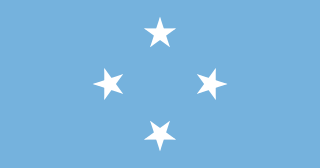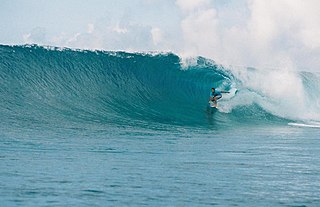
The Federated States of Micronesia is an island country in Oceania. It consists of four states—from west to east, Yap, Chuuk, Pohnpei and Kosrae—that are spread across the western Pacific. Together, the states comprise around 607 islands that cover a longitudinal distance of almost 2,700 km (1,700 mi) just north of the equator. They lie northeast of Indonesia and Papua New Guinea, south of Guam and the Marianas, west of Nauru and the Marshall Islands, east of Palau and the Philippines, about 2,900 km (1,800 mi) north of eastern Australia, 3,400 km (2,100 mi) southeast of Japan, and some 4,000 km (2,485 mi) southwest of the main islands of the Hawaiian Islands.

The Federated States of Micronesia are located on the Caroline Islands in the western Pacific Ocean. The history of the modern Federated States of Micronesia is one of settlement by Micronesians; colonization by Spain, Germany, and Japan; United Nations trusteeship under United States-administered Trust Territory of the Pacific Islands; and gradual independence beginning with the ratification of a sovereign constitution in 1979.

Micronesia is a subregion of Oceania, consisting of about 2,000 small islands in the Northwestern Pacific Ocean. It has a close shared cultural history with three other island regions: Maritime Southeast Asia to the west, Polynesia to the east, and Melanesia to the south—as well as with the wider community of Austronesian peoples.

Palikir is the capital city of the Federated States of Micronesia located in the western Pacific Ocean. A town of slightly under 5,000 residents, it is part of the larger Sokehs municipality, which had a population of 6,647 as of 2010, out of the nation's total population of 106,487. It is situated on the northwest side of Pohnpei island, a high volcanic island surrounded by a fringing coral reef. Nearby to the northeast is the island's largest settlement, the coastal town of Kolonia. It was declared the capital of Micronesia in 1989.

Kosrae, formerly known as Kusaie or Strong's Island, is an island in the Federated States of Micronesia. The State of Kosrae is one of the four states of the Federated States of Micronesia, and includes the main island of Kosrae and a few nearby islands and islets, the most significant of which is inhabited by 1,500 people.
The Micronesians or Micronesian peoples are various closely related ethnic groups native to Micronesia, a region of Oceania in the Pacific Ocean. They are a part of the Austronesian ethnolinguistic group, which has an Urheimat in Taiwan.

The traditional music of the Federated States of Micronesia varies widely across the four states, and has, in recent times, evolved into popular music influenced by Europop, country music and reggae.

Chuuk State is one of the four states of the Federated States of Micronesia (FSM). The other states are Kosrae State, Pohnpei State, and Yap State. It consists of several island groups: Namoneas, Faichuuk, the Hall Islands, Namonuito Atoll, Pattiw, and the Mortlock Islands. Chuuk is the FSM's most populous state, with 50,000 inhabitants on 120 square kilometers. Chuuk Lagoon is where most people live. Weno island, in the lagoon, is Chuuk's state capital and the country's biggest city. It may hold a referendum on independence in the near future, although this referendum has been repeatedly postponed.

Yap State, is one of the four states of the Federated States of Micronesia (FSM). The other states are Kosrae State, Pohnpei State, and Chuuk State.
Micronesian Americans are Americans who are descended from people of the Federated States of Micronesia. According to the 2010 census, a total of 8,185 residents self-identified as having origins in the country, which consists of four states. More than half of these residents identified their origin as Chuuk State (4,211) with the rest as follows: 2,060 people from Pohnpei, 1,018 from Yap, and 906 people from Kosrae.

Yap traditionally refers to an island group located in the Caroline Islands of the western Pacific Ocean, a part of Yap State. The name "Yap" in recent years has come to also refer to the state within the Federated States of Micronesia, inclusive of the Yap Main Islands and its various outer islands, the Yap Neighboring Islands. For specifying the island group, the name Yap Main Islands is most exact.

Japanese Micronesians, also Nikkei Micronesians or Micronesians of Japanese descent, refers to citizens of the Federated States of Micronesia (FSM) who are of Japanese descent and are members of the Japanese global diaspora known as the Nikkei (日系).
Sebastian L. Anefal is a Micronesian politician currently serving as the FSM Ambassador Plenipotentiary to Fiji. He was nominated by President Peter M. Christian to his current post in mid-2015 and took office on January 8, 2016.

The office of the Governor of Yap is the highest elected position in the state of Yap, Federated States of Micronesia.

Women in the Federated States of Micronesia are women who live in or are from the Federated States of Micronesia, an independent sovereign island nation composed of four states. Thus, FSM women includes women from the States of Yap, Chuuk, Pohnpei and Kosrae.

Gilman is a village and municipality in the state of Yap, Federated States of Micronesia. It lies on the south side of the Yap island. Six villages or hamlets are integrated there : Anoth, Gachlaw, Guror, Magchagil, Thabeth and Towoway. The population was 252 in 2010.

Yap Day is a legal holiday in Yap State, one of the four states of the Federated States of Micronesia (FSM), held annually on March 1. It is a celebration of traditional Yapese culture. Common activities held during this time include competitions and traditional dances.
Religion in Yap is predominantly Roman Catholic, which first arrived in Yap in the late 1880s. Before that, the Yapese people practiced traditional rituals and practices and held beliefs about the gods, the spirits, taboos, and death. Through the efforts of Capuchin and Jesuit missionaries, the Catholic Church eventually became the dominant church on Yap. Other religions on Yap include Protestantism and other Christian sects.

The Church of Jesus Christ of Latter-day Saints in the Federated States of Micronesia refers to the Church of Jesus Christ of Latter-day Saints and its members in the Federated States of Micronesia (FSM). The church's first known missionaries arrived on July 5, 1978. As of December 31, 2021, there were 6,107 members in 23 congregations in FSM. The LDS Church has congregations in every state in the FSM.
The traditional councils of the Yap State are two assemblies of traditional leaders: the Pilung Council for the chiefs of the Yap Islands and the Tamol Council for the chiefs of the Outer Yap Islands. They have been established in 1992 by the Constitution of the Yap State, within the Federated States of Micronesia. The executive, the legislative, the judiciary and the traditional councils are the four institutional branches of government in the Yap State, but the councils, unlike the others, transcend the concept of the separation of powers. The councils are responsible for exercising the functions that relate to tradition and custom, which are not required to be recorded in the written law. In the Yap State, custom and tradition prevail over any interpretation of the constitution and even over any judicial decision. The councils have the right to veto legislation that they consider to be contrary to traditional practices. The constitutionality of these councils and their veto power could be challenged under the Micronesian Federal Constitutional Law, but to this date no one has done it.













